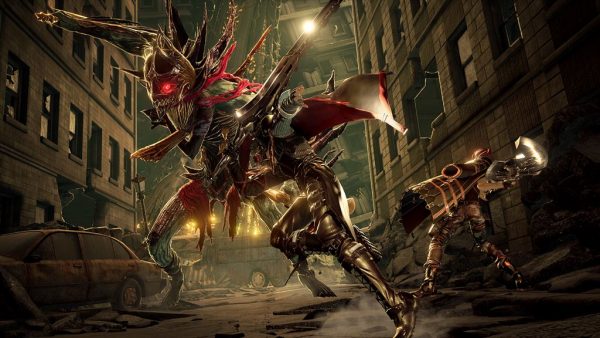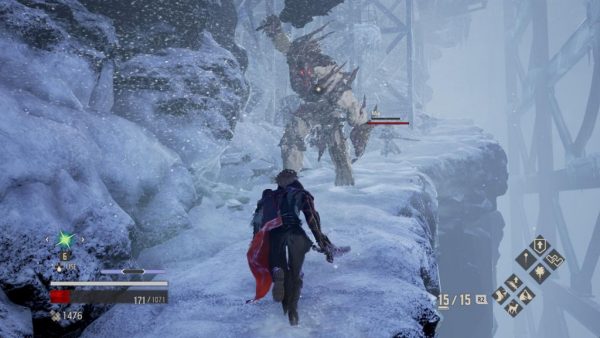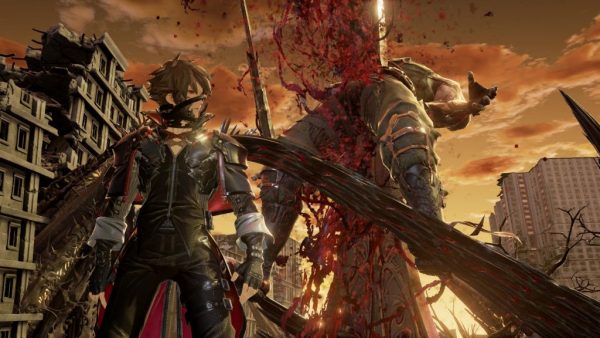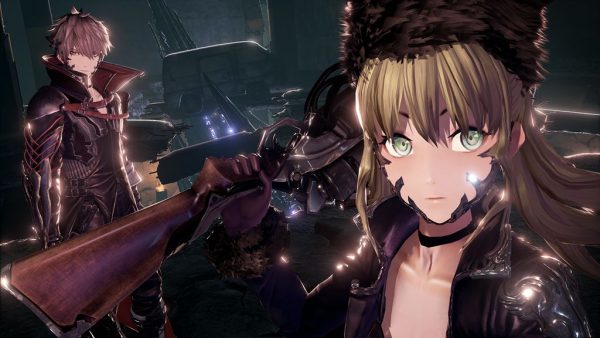Also On: PS4, Xbox One
Publisher: Bandai Namco
Developer: Shift/Bandai Namco Studios
Medium: Digital/Disc
Players: Multi
Online: Yes
ESRB: M
If Dark Souls had an easy mode
When discussing Code Vein, the first thing that will inevitably come up is the comparison to the Dark Souls series. Before the game had even gone gold, people had dubbed it ?Anime-Souls?, due to the way combat appeared to play out, the massive boss fights, the unique progression system, and various other gameplay aspects we have come to associate with the From Software games. When I started my 35-ish hour journey with Code Vein, I wholeheartedly agreed with that sentiment. Aside from the very anime-inspired artwork and cutscenes, the whole opening of the game plays like a love letter to the Souls series. Currency for leveling up and buying items takes the form of mist, which is accumulated just like souls are in the Souls series. Upon death, you lose all of your mist at the place where you died, and must return and recover it all before another death, or else you will lose them forever. ?Mistle? populate the levels, which are the equivalent of the bonfires in Souls, allowing you to rest and recover your healing items and level up, but also resetting the world-state and respawning all the enemies aside from the bosses.
Combat is a methodical series of attacks, blocks, dodges, parries, and rolls. Different enemies will require a different approach, and sometimes what you might typically do will fail and you will have to approach an opponent in an entirely new way. The first big deviation from the Souls formula is the new mechanic called ?Blood Codes?. These act as a swappable class system. Some Blood Codes focus on strength, aiding in combat with two-handed weapons and have a low Ichor stock. Ichor is how you use your blood gifts, which can be likened to sorceries in a Souls game. Blood gifts are much more varied than sorceries are, but I will cover that later.
If you are someone who was always interested in the Souls games but were turned away by the steep learning curve and high difficulty, Code Vein might just be the perfect game for you. Code Vein retains a level of difficulty that merits cautious exploration and a measured approach to every encounter, along with all of the gameplay elements that make Souls so great but dials the difficulty back to like a six. I would say I beat about half of the bosses on my first try, with all but one of the other half falling to me on my second attempt. The one boss that gave me trouble was a magic-based opponent with huge AOE attacks that made my chosen playstyle an absolute nightmare. Once I stopped being stubborn and changed up my Blood Code and Gift set, I took her down with relative ease. This is all while playing by myself (aside from the AI in-game companion).
For players that are new to games like this though, the Souls-like summon system is in place here, and better than ever. Now, there does not seem to be the same level based pairing, or even location-based pairing if you have a friend trying to help you. I went back through and spent a good amount of time experimenting with the summon system after I finished the game, and with open matchmaking, I had help in seconds and never failed to find someone that I could help when I put myself out there. When I threw the password matchmaking on to play with a friend, he could summon me from wherever I was in the world. We could be in totally different areas, facing totally different bosses and he could summon me for his fight. The one downside I found to this was the potential for spoilers. I started a brand new game to test the summoning out, and more than once was summoned for a boss fight that in that current playthrough, I had not yet done.
Blood, blood and more blood
Everything in Code Vein revolves around blood. You are a revenant, a semi-immortal vampire-like creature that survives on blood. If you do not feed on enough blood, you eventually lose yourself and become one of the ?lost?, not unlike a Hollow in Dark Souls. Most of the opponents you fight throughout the game are members of the lost, former revenants who have gone entirely mad. I won?t spoil anything and go into much more detail than that, but the way the lost tie in with the world and how the revenants came to-be play a big part in the story of Code Vein.
In addition to the story, gameplay revolves around blood as well. You accumulate blood, or ?Ichor?, and use it to execute your abilities. Ichor is gathered in several ways, either through attacking your opponent, using special, charged drain attacks or through super-powerful backstab drains. The amount of Ichor you can hold at a time is influenced by your Blood Code. Blood Codes are like a class system, and it will take some time to figure out exactly what the best one is for you. Some focus on strength and two-handed weapon fighting, some focus on speed and recovery, some focus on ranged attacks and so on and so forth. You start with 3 available codes, but there are 31 more to be found throughout the world. That goes to show you just how many ways this game can be played. Code Vein brings an unparalleled level of versatility to the Souls formula, with each Blood Code playing differently and bringing unique abilities to the table.
Within each Blood Code are the Gifts. These are the actual abilities/attacks/power-ups that you use in and out of combat. Melee focused codes will have strong combos that you can unleash to stun an opponent, whereas a caster build will have the equivalent of spells that you can use. There are weapon buffs, health buffs, last-ditch saves, companion resurrections and so many more. You are initially limited to using only the gifts within your chosen code, but after some time you begin to accumulate upgrade materials called ?Awake? with various letter and number designations that follow, which allow you to max out your proficiency with a certain gift, in turn allowing you to equip it with an entirely different Blood Code. Different Blood Codes have different base Ichor amounts. I played Atlas most of the time, a melee-focused strength code, which has a relatively low Ichor count (10) but allowed me to move at a normal speed with heavy weapons equipped. Caster codes may have a much higher Ichor count but you can’t carry a massive greatsword and still move about freely. The builds are virtually endless, pairing up the proper armor with your chosen Blood Code, and finding the right weapons and Gifts to accompany it. It definitely takes some trial and error, as well as time to get used to, but I see myself playing Code Vein over and over to experience all that it has to offer.
A deeply personal story
The story in Code Vein is much more apparent than Souls fans will be used to, with long, plentiful cutscenes and a fully voiced cast of characters. In addition to the in your face story elements, you can learn a lot more about individual characters and the background of the world through ?Vestiges?. These are hidden collectibles, sometimes found hiding in the world behind a tough opponent, or gained after defeating a boss, or gained by completing side quests for the various NPCs that pop up throughout the campaign. Once you acquire a vestige, you can turn them into your companion Io at the home base, which is essentially Firelink Shrine. You are safe here, and any companions you collect throughout the game will come here for you to interact and trade with. Io is also essentially the firekeeper. She is who you go to for story progression and to turn in your vestiges. Once you turn a vestige in, you enter a dreamlike world, in which you walk (exceptionally slowly) through a mostly empty space populated by pop up dioramas and audio tracks that tell the story of what is happening. These are all lost memories of other revenants that deepen their backstory and character development. If these do not interest you, you can simply turn the vestiges in and skip the cutscenes, but I do not recommend it unless you are trying to speedrun. This allows you to still get the companionship benefits that come along with recovering the vestiges, as well as the Blood Gifts that they unlock.
The story in Code Vein is a deeply personal one. The overarching ?save the world? plot is well designed and interesting enough, but Code Vein shines in the quieter moments. There is a lot of importance placed on individual characters and the way they perceive your character. You can choose to help people, either by saving their loved ones or restoring their memories, or you can ignore them. There are three unique endings to Code Vein, and if you want the ?complete? or ?good? ending, you have to take the time to get to know your companions and strengthen those relationships. Again, this is in no way a chore. The absolute best parts of the story take place in those relationships and interactions. I cared much more about helping Mia save her brother than I did about saving the world.
In addition to the genuine story moments, the developers further incentivize you to care for your companions by adding them as gameplay partners as well. You can choose one companion at a time to accompany you on your journey, and these can be switched as often as you like at the home base. Each one has a unique Blood Code and set of Gifts, as well as a unique playstyle. I played a very melee focused strength build with a massive two-handed greatsword and a Blood Code with Gifts that followed suit. I chose Mia as my companion for most of the game, as she is a ranged/caster type character with high Ichor and great elemental and distance-based Blood Gifts. This allowed me to get up in the bosses faces while she hit them with various abilities from afar. Vice versa, if I were to play a caster build, I might take someone like Louis with me to hold some aggro and get up close while I smash them with magic from a distance.
Occasionally I found myself frustrated with the AI companion, but those times were few and far between. There were times where we would start a boss fight, and 3 seconds in I see the on-screen message ?Mia has been defeated?. Okay Mia, thanks for the assistance. There were other times that I would go down in a swarm out in the world and she would have her resurrect ability available but just refused to save me, leaving me to start the area over and try and recover my mist. Again, these instances were very rare, and I found the companion AI to be exceptionally well programmed to help me in the most effective way possible based on the current situation. If you play the game with one main companion, you will get rather tired of the repetitive library of 10 or so voice lines reminding you that you are low on healing, or you can turn around and try later, or ?wow, what an amazing find? when you get some mundane and mostly useless item off the ground. When something truly important DOES happen though, your companion is usually there to talk you through some interesting story beat and genuinely adds something to what it happening, further deepening the story and the world.
A genuinely incredible game
When I finished my 35-ish hour first playthrough of Code Vein, I was truly surprised it had been that long. Code Vein is a fun, fresh take on the Souls formula, and a genuinely incredible game. All I wanted to do when I finished was start over and try out some new Blood Codes and try and get one of the alternate endings. Code Vein is the perfect starting point for that friend that always wanted to try Dark Souls but couldn?t get into it because it was ?too hard?. It is also a great choice for Souls veterans to whet your appetite while you eagerly await the next genuine From Software offering. There are so many unique and fun changes here that, although there is a definite difficulty decrease, you will really enjoy yourself.
Note: Bandai Namco provided us with a Code Vein PC code for review purposes.






